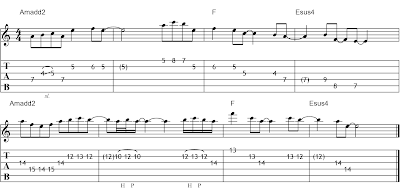Exotic Pentatonic 101 [KUMOI SCALE]
Have you ever listened to those awesome sounding exotic lines performed by the likes of Joe Satriani, Marty Friedman and Steve Vai? Afterward you might have been left wondering "What Scales are they Playing?" In this post, I'm going to break down one of the most popular exotic Pentatonic scales used by guitarists to help promote truly unique sounds in music...
Lets venture into the sound of Exotic Pentatonic scales with a really cool Pentatonic Minor called the Kumoi Scale. Also, sometimes called the “Japanese Scale.”
WATCH THE VIDEO:
The Kumoi scale is a 5-tone Pentatonic that has a very minor color due to its tonality established off of the Tonic note. In this scale, we have a major 2nd, to a minor 3rd and then we move to a perfect 5th, and finally up to the Minor 6th, (1, 2, b3, 5, b6).
It’s a unique group of intervals with a lot of ½ steps, that can offer some really cool sounds that evoke the direction of both Eastern Asia and Western Asia. And, aside from Asian music, you’ll hear it used in Jazz, in Fusion and in Progressive Rock and Metal too. So, let’s get things started with learning a couple of scale pattern shapes off of the 6th and 5th strings...
TWO (2) KUMOI SCALE PATTERNS:
The first pattern that we’ll learn will be a shape that is based upon the sixth string which is constructed off of the Tonic note of “A.” This will give us a scale that consists of the notes; “A, B, C, E and F.” Here’s how it looks on the fingerboard.
The next shape for this scale will be built off of the 5th guitar string and to keep things consistent we’ll remain off of the Tonic note of “A” once again. Here’s the 5th string root pattern (in 12th position) for performing another key of, “A” Kumoi scale…
KUMOI HARMONY APPLICATION:
This exotic sounding Pentatonic scale can be used in a fair amount of Minor key situations because it contains all of the notes found within the common “Natural Minor” Scale.
Kumoi scale is only missing the Natural Minor’s Perfect 4th interval and the scales “Minor 7th.” In effect, you could actually say that the “Kumoi” Scale is a Natural Minor Scale with the 4th and 7th degrees removed...
In getting started exploring harmony with the Kumoi, let’s establish a key of, “A Minor” progression that highlights this scales Tonic chord, along with the 5th and 6th degree chords. This means that our progression will be using the chords of, “A Minor,” “F Major,” and “E sus 4.”
Study the riff I've established for the progression, it is shown below in TAB and notation. The riff uses those chords we had selected and builds the harmony from off of the Kumoi scale's first, 5th and 6th scale steps...
Kumoi Riff Progression:
KUMOI MELODIC APPLICATION:
Now that you understand the idea of this minor tonality sound and how we could apply the scales Tonic, the Minor 6th and the Perfect 5th degrees (to produce a chord progression), let’s take things a step further.
Our melodic example will establish a strong melody line that you can play from the Kumoi scale. Our melody will cover those chord changes from our previous study.
In the example below I've created an 8-bar melodic idea that you can learn. This melody line will help you to have someplace to start from in getting yourself going for future practice and the future application of this unique scale on guitar…
Kumoi 8-Bar Practice Melody:
CONCLUSION:
If you study scales used in the Asian musical traditions, what you’re going to find is that there are a lot of combinations of pitches being used within different musical cultures. And, most of these are of the 5-tone Pentatonic scale.
These layouts will have interesting /exotic musical sounds, and it’s well worth it to spend some time studying how these different pentatonic scales are used in the music played by Jazz players like Pat Metheny and John Scofield, as well as, a lot of rock and metal players like; Marty Friedman, Joe Satriani, Dave Mustaine and Steve Vai.
And, although the interval layout of the Japanese Kumoi scale is really close to the Natural Minor scale, it is the way that the wider intervals combine with all the semitones that really brings out that unique flavor. Having a similar result is pretty hard to come by if you’re only thinking across the scale layout /tones of the Natural Minor.
VISIT THE WEB-SITE:
Thanks for joining me, If you'd like to Find Out What You Should Learn Next on Guitar - take a look at the courses over on my website at CreativeGuitarStudio.com.
My step-by-step; Beginner, Intermediate and Advanced courses will cover what you need to know, along with how to be able to move forward and become the best player that you can be.
I've worked on these courses since 1992 and I feel that all together they're the best guitar program that you'll ever find. The courses will help you learn to identify what's required to get you up to the next level of guitar playing, in a very organized way, that makes sense.
So, I look forward to helping you further at CreativeGuitarStudio.com ...Until next time, take care and we'll catch up again on the next lesson. Bye for now!
Lets venture into the sound of Exotic Pentatonic scales with a really cool Pentatonic Minor called the Kumoi Scale. Also, sometimes called the “Japanese Scale.”
WATCH THE VIDEO:
_____________________________________________________
_____________________________________________________
The Kumoi scale is a 5-tone Pentatonic that has a very minor color due to its tonality established off of the Tonic note. In this scale, we have a major 2nd, to a minor 3rd and then we move to a perfect 5th, and finally up to the Minor 6th, (1, 2, b3, 5, b6).
It’s a unique group of intervals with a lot of ½ steps, that can offer some really cool sounds that evoke the direction of both Eastern Asia and Western Asia. And, aside from Asian music, you’ll hear it used in Jazz, in Fusion and in Progressive Rock and Metal too. So, let’s get things started with learning a couple of scale pattern shapes off of the 6th and 5th strings...
TWO (2) KUMOI SCALE PATTERNS:
The first pattern that we’ll learn will be a shape that is based upon the sixth string which is constructed off of the Tonic note of “A.” This will give us a scale that consists of the notes; “A, B, C, E and F.” Here’s how it looks on the fingerboard.
The next shape for this scale will be built off of the 5th guitar string and to keep things consistent we’ll remain off of the Tonic note of “A” once again. Here’s the 5th string root pattern (in 12th position) for performing another key of, “A” Kumoi scale…
KUMOI HARMONY APPLICATION:
This exotic sounding Pentatonic scale can be used in a fair amount of Minor key situations because it contains all of the notes found within the common “Natural Minor” Scale.
Kumoi scale is only missing the Natural Minor’s Perfect 4th interval and the scales “Minor 7th.” In effect, you could actually say that the “Kumoi” Scale is a Natural Minor Scale with the 4th and 7th degrees removed...
In getting started exploring harmony with the Kumoi, let’s establish a key of, “A Minor” progression that highlights this scales Tonic chord, along with the 5th and 6th degree chords. This means that our progression will be using the chords of, “A Minor,” “F Major,” and “E sus 4.”
click on the above image to enlarge full-screen
Study the riff I've established for the progression, it is shown below in TAB and notation. The riff uses those chords we had selected and builds the harmony from off of the Kumoi scale's first, 5th and 6th scale steps...
Kumoi Riff Progression:
click on the above image to enlarge full-screen
KUMOI MELODIC APPLICATION:
Now that you understand the idea of this minor tonality sound and how we could apply the scales Tonic, the Minor 6th and the Perfect 5th degrees (to produce a chord progression), let’s take things a step further.
Our melodic example will establish a strong melody line that you can play from the Kumoi scale. Our melody will cover those chord changes from our previous study.
In the example below I've created an 8-bar melodic idea that you can learn. This melody line will help you to have someplace to start from in getting yourself going for future practice and the future application of this unique scale on guitar…
Kumoi 8-Bar Practice Melody:
click on the above image to enlarge full-screen
CONCLUSION:
If you study scales used in the Asian musical traditions, what you’re going to find is that there are a lot of combinations of pitches being used within different musical cultures. And, most of these are of the 5-tone Pentatonic scale.
These layouts will have interesting /exotic musical sounds, and it’s well worth it to spend some time studying how these different pentatonic scales are used in the music played by Jazz players like Pat Metheny and John Scofield, as well as, a lot of rock and metal players like; Marty Friedman, Joe Satriani, Dave Mustaine and Steve Vai.
And, although the interval layout of the Japanese Kumoi scale is really close to the Natural Minor scale, it is the way that the wider intervals combine with all the semitones that really brings out that unique flavor. Having a similar result is pretty hard to come by if you’re only thinking across the scale layout /tones of the Natural Minor.
VISIT THE WEB-SITE:
Thanks for joining me, If you'd like to Find Out What You Should Learn Next on Guitar - take a look at the courses over on my website at CreativeGuitarStudio.com.
My step-by-step; Beginner, Intermediate and Advanced courses will cover what you need to know, along with how to be able to move forward and become the best player that you can be.
I've worked on these courses since 1992 and I feel that all together they're the best guitar program that you'll ever find. The courses will help you learn to identify what's required to get you up to the next level of guitar playing, in a very organized way, that makes sense.
So, I look forward to helping you further at CreativeGuitarStudio.com ...Until next time, take care and we'll catch up again on the next lesson. Bye for now!
___________________________________________________
GET GOOD NOW - JOIN THE MEMBERS AREA
Guitar Chords | F Chord | Guitar Notes | G Chord | C Chord | D Chord | Guitar String Notes
















